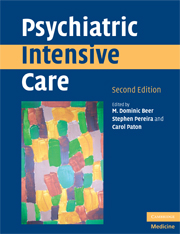Book contents
- Frontmatter
- Contents
- List of contributors
- Preface to second edition
- Preface to first edition
- Foreword
- Part I Therapeutic interventions
- 1 Psychiatric intensive care – development and definition
- 2 Management of acutely disturbed behaviour
- 3 De-escalation
- 4 Rapid tranquillisation
- 5 Pharmacological therapy
- 6 Psychological approaches to the acute patient
- 7 Psychological approaches to longer-term patients presenting with challenging behaviours
- 8 Seclusion – past, present and future
- 9 Restraint and physical intervention
- 10 The complex needs patient
- 11 Therapeutic activities within Psychiatric Intensive Care and Low Secure Units
- 12 Risk assessment and management
- Part II Interface issues
- Part III Management of the Psychiatric Intensive Care Unit/Low Secure Unit
- Index
- References
1 - Psychiatric intensive care – development and definition
from Part I - Therapeutic interventions
Published online by Cambridge University Press: 22 August 2009
- Frontmatter
- Contents
- List of contributors
- Preface to second edition
- Preface to first edition
- Foreword
- Part I Therapeutic interventions
- 1 Psychiatric intensive care – development and definition
- 2 Management of acutely disturbed behaviour
- 3 De-escalation
- 4 Rapid tranquillisation
- 5 Pharmacological therapy
- 6 Psychological approaches to the acute patient
- 7 Psychological approaches to longer-term patients presenting with challenging behaviours
- 8 Seclusion – past, present and future
- 9 Restraint and physical intervention
- 10 The complex needs patient
- 11 Therapeutic activities within Psychiatric Intensive Care and Low Secure Units
- 12 Risk assessment and management
- Part II Interface issues
- Part III Management of the Psychiatric Intensive Care Unit/Low Secure Unit
- Index
- References
Summary
Historical background
Throughout human history different cultures have had to manage their most behaviourally disturbed and mentally ill members. Turner (1996) has written that historically psychiatry has been judged by its management of the ‘furiously mad’. Nearly three thousand years ago the King of Babylon was put to pasture (literally) after he started to behave like a wild animal (Book of Daniel). Two thousand years ago we read in the New Testament of a wild man wandering naked amidst the tombs, having broken the chains that bound him.
Seven hundred and fifty years ago the first ‘asylum’ for mental patients in England was formed at the Priory of St Mary of Bethlehem in London. ‘Bethlem’ became the national hospital for the disturbed mentally ill. The patient's parish of origin would pay for a stay of usually up to a year. Abuses however came to light, none better known than the case of William Norris in 1814, which prompted a parliamentary enquiry. The unfortunate man had been kept for seven years in a cell and restrained mechanically so that he could move no more than twelve inches.
Nineteenth century psychiatrists such as John Conolly then embraced ‘non-restraint’, but many hospitals remained locked. The Mental Treatment Act 1930 introduced the concept of patients being admitted informally and by 1938 such patients constituted 35% of the total (Jones 1993). The Royal Commission on the Law Relating to Mental Illness and Mental Deficiency (1954–57) stressed that patients should be treated informally where possible.
- Type
- Chapter
- Information
- Psychiatric Intensive Care , pp. 3 - 11Publisher: Cambridge University PressPrint publication year: 2008
References
- 1
- Cited by

